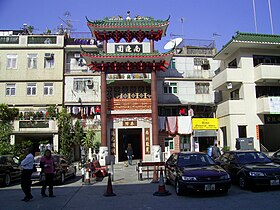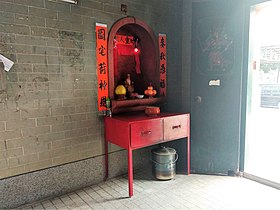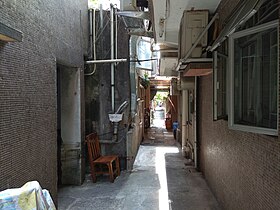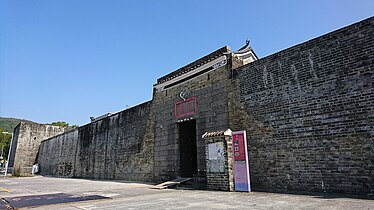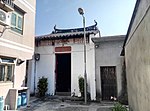
Sheung Shui is an area in the New Territories, Hong Kong. Sheung Shui Town, a part of this area, is part of the Fanling–Sheung Shui New Town in the North District of Hong Kong. Fanling Town is to its southeast.

Ping Shan Heritage Trail is a heritage trail located in the Ping Shan area of Yuen Long District, in Hong Kong. The trail was inaugurated on 12 December 1993 and was the first of its kind in Hong Kong. It passes through the villages of Hang Tau Tsuen, Hang Mei Tsuen and Sheung Cheung Wai and it includes several declared monuments and graded buildings.

Sheung Shui Wai, also known as Sheung Shui Heung (上水鄉) is an area in Sheung Shui, in the northern part of the New Territories of Hong Kong. Its population is around 6,000 people.

Lam Tsuen is an area in Tai Po District, Hong Kong, noted for its Lam Tsuen wishing trees. The nearby Lam Tsuen River, empties into Tai Po Hoi.

Shap Pat Heung is an area in the New Territories of Hong Kong. Located south of Yuen Long and northeast of Tai Tong, the area occupies the plain north of hills of Tai Lam. The Cantonese name 'Shap Pat Heung' means 'eighteen villages' at its beginning. It was later expanded to thirty villages. Administratively, it is part of the Yuen Long District.
The Tang Clan of Hong Kong is one of the Five Great Clans of the New Territories (新界五大氏族). The others are Man, Hau, Pang and Liu.

Lung Yeuk Tau, commonly known as Lung Ku Tau and also called Lung Ling is an area located northeast of Luen Wo Hui in Fanling, New Territories, Hong Kong.

Tin Hau temples in Hong Kong are dedicated to Tin Hau (Mazu). Over 100 temples are dedicated to Tin Hau in Hong Kong. A list of these temples can be found below.

Ying Lung Wai is a walled village in the Yuen Long Kau Hui area of Yuen Long District, Hong Kong.

Yuen Long Kau Hui is an area in Yuen Long, Yuen Long District, in the western New Territories of Hong Kong.

Nam Pin Wai, sometimes transliterated as Nam Bin Wai, is a walled village in the Yuen Long Kau Hui area of Yuen Long District, Hong Kong.

Wing Lung Wai is a walled village located in the Kam Tin area of Yuen Long District, in Hong Kong. Three other walled villages, Kat Hing Wai, Tai Hong Wai, and Kam Hing Wai are located nearby and were built around the same time.

Tin Sam Village or Tin Sam Tsuen, sometimes transliterated as Tin Sum, is a village in Tai Wai, Sha Tin District, Hong Kong. It is located west of Sun Chui Estate, north of Lung Hang Estate, and southeast of Festival City. Part of Tin Sam Village consists of Tin Sam Wai (田心圍), a historic walled village.

Tan Chuk Hang is a village of Hong Kong, located in Fanling, North District. It comprises Tan Chuk Hang Lo Wai and Tan Chuk Hang San Wai aka. Sheung Tan Chuk Hang.

Wing Ning Wai is a walled village in Lung Yeuk Tau, Fanling, Hong Kong. It is one of the Five Wai and Six Tsuen (villages) in Lung Yeuk Tau.

Ho Sheung Heung is an area in Sheung Shui, North District, Hong Kong.

San Wai or San Wai Tsuen (新圍村) is a village in the San Tin area of Yuen Long District, Hong Kong.
The Nine Alliances of Lek Yuen or Kau Yeuk was a regional organization of various groups in Sha Tin Valley, Hong Kong.



